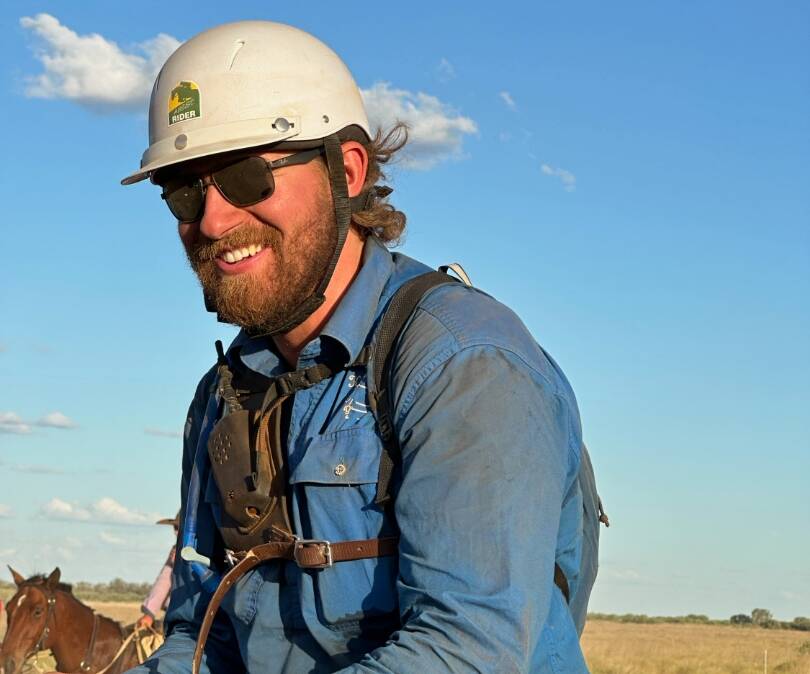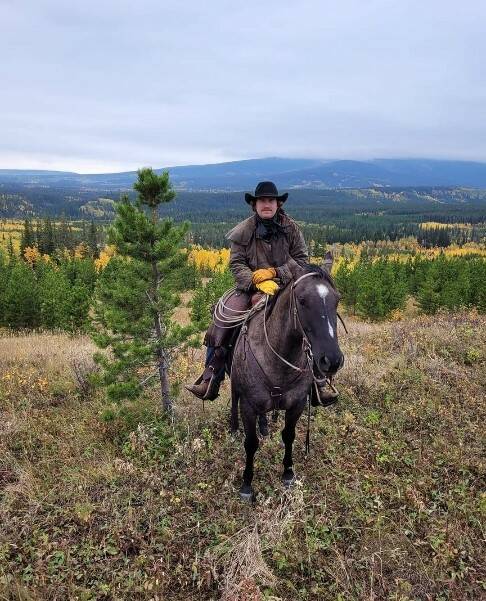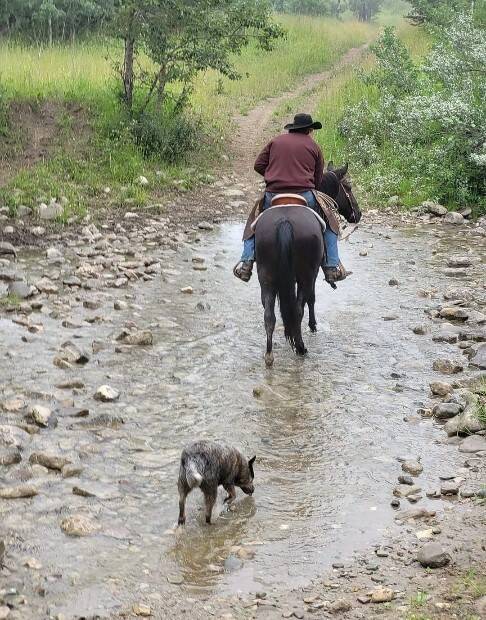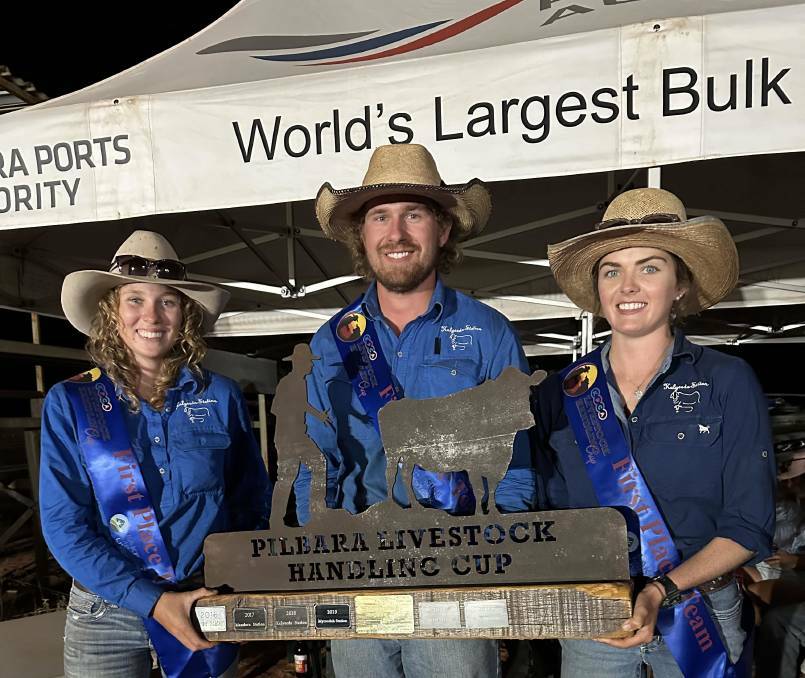
Mustering on horseback across vast and sparsely populated stretches of red Kimberley dirt, Liam Hinch is a long way from home.
At just 24-years-old, the Canadian moved to northern WA to fulfill his dream of working on an outback cattle station.
Admittedly, it was a collection of DVDs featuring iconic Australian zookeeper and wildlife conservationist Steve Irwin that started Mr Hinch's fascination with Down Under.
"I was a big fan of Steve Irwin and always thought Australia was interesting," Mr Hinch said.
"Then in high school I started seeing videos on social media of people in Australia mustering cattle with helicopters.
"That sparked my interest even more and, after gaining a better understanding of what stations were like and how they worked, I decided I wanted to move there."
Life on the ranch
It is fair to say livestock runs deep in the Hinch family name.
Mr Hinch is the fifth-generation on the home ranch, known as Bar FX ranches, in Mountain View, Alberta.
Spread across more than 500 hectares, the property is home to a mixed Black Angus, Charolais and Simmental herd of about 180 cow-calf pairs.
In recent years, the family has been fortunate enough to increase its land size, after signing a lease with the Nature Conservancy of Canada.
Mr Hinch said his earliest memories on the ranch involved saddling up and helping his parents move and gather cows.
And he loved it, at least until reaching high school.
"When I was young I really liked it and always wanted to be around it," Mr Hinch said.
"Then in high school my interests kind of changed and I was big into sports.
"I would still help out with the bigger jobs such as branding cattle, but I didn't want to work on or take over the ranch."
Despite this, Mr Hinch still planned on moving to Australia after school, however his plans were hindered by a bad sports injury that took a long time to recover.
He went on to study science at a university in the city instead, with the idea of eventually moving on to pharmacy school.
Perhaps it was a case of 'everything happens for a reason' because it was there his mindset changed, as he started to miss and appreciate home and the country way of life.
While at university, Mr Hinch quickly learned science wasn't for him and swapped to study "a more universal" course - business.
In reality, all he wanted to do was work with cattle.
"Once I left, I realised how cool and unique it is that the ranch has been in my family for that long," Mr Hinch said.
"I missed everything about it, the way of life when you are growing up as a kid.
"I was attending university only three hours away from home, so I was able to visit on the weekends and lend a hand with muster, fencing, cleaning up the yards or whatever jobs needed to be done.
"During summer break, I moved back home to work and also worked with another local cattle rancher."
Mr Hinch said keeping the ranch in the family motivated him to stay in the industry.
Having studied business, and with the injury limiting what he could and couldn't do, Mr Hinch landed a job at a bank.
As was the case with studying science, it wasn't for him.
"I hated going in every single day - just the idea of an office or a cubicle," Mr Hinch said.
"Then the dream came back up again and I started to spend a lot of time at work looking up different cattle stations, jobs and areas in Australia.
"Just over a year ago, mum and I were checking on the cows and I said 'I think I'm going to go to Australia'.
"Not long after I applied for my visa and moved over in January this year."

Making the move
After spending a few weeks in Sydney, Mr Hinch moved to a cattle property about an hour south of Canberra.
Similarly to his family's ranch back home, the 5600ha property ran a black Angus cattle herd.
"I spent three months there and it was awesome because my manager had worked on cattle stations for 10-plus years as well," Mr Hinch said.
"Other employees there had done seasons as well, so I was able to ask all sorts of questions in preparation.
"Knowing what to expect and how to prepare definitely made the move to northern WA easier."
Taking advice from those around him, Mr Hinch decided to post a job call-out on different Facebook groups.
He wrote that he was looking to work as a station hand and let social media do what it does best.
Through the power of the platform, Mr Hinch was given options and he was drawn to the Kimberley.
Among the offers he received was one from Camille Camp at Kalyeeda station, south of the Fitzroy River.
Mr Hinch saw it as an opportunity too exciting to turn down, particularly given the Camp family used horses at muster.
He accepted, packed up his bags and set off on the adventure of a lifetime.
It was not until hitting the road that reality sunk in.
"The drive up was intense," Mr Hinch said.
"Obviously Australia is really big and I had to drive all that way on my own.
"I was on crunch time to get there because I wanted to make it in time for the livestock low stress handling course.
"When I left I had five days to get to Kalyeeda, I was pushing hard driving 16 hour days."
Mr Hinch stopped at Mildura, Victoria, then a roadhouse in northern South Australia close to the Northern Territory border, Uluru and finally Katherine.
Sleeping in his car on the side of the road after arriving at Katherine, he woke up the next morning and decided to get going again.
However, just 30 kilometres out, the road trip took an unexpected turn.
"It was still dark when I left and I hit a wallaby head-on with my car," Mr Hinch said.
"It completely chucked out my radiator and was stressful to say the least.
"I had to get towed back into town and order a radiator as quickly as I could.
"I ended up spending five nights there until everything was sorted and missed the low stress livestock handling course.
"I was very hesitant to drive in the dark after that."

Worlds apart
Running cattle on a ranch in Canada is a little different to a station in the Kimberley.
For Mr Hinch the most obvious differences are the size, remoteness and climate.
For example, Kalyeeda runs 10,000 head of cattle across 122,000ha, with temperatures reaching 40-plus degree highs, whereas Bar FX Ranches runs 180-head across 500ha, often in sub-zero conditions.
"I remember arriving at Kalyeeda and thinking - what do the cattle eat up here?," Mr Hinch said.
"In New South Wales there was so much grass, but the Kimberley was much more dry.
"I also couldn't believe how remote it was.
"You could take a turn off the highway and be driving for five hours until you got to where you needed to be."
Taking a look more closely at his own family operation, Mr Hinch said after a 45-day joining in June, calving generally started between late February and early March.
At the end of April, depending on the weather and moisture, branding is completed before cattle are moved onto summer pastures until September.
While in stark contrast to northern WA, Mr Hinch said the past few seasons at home had been "really dry" at the ranch and grass hadn't lasted as long.
He said calves were usually weaned and sold into auction or the feedlot right off the cows.
"We usually keep about 20 replacement heifers to keep the herd young and healthy and cull anything that is getting older or starts getting cranky," he said.
"But it depends on the year - if the grass is short and hay is short we might sell those calves earlier."
Fighting to have enough feed over winter, the Hinches pregnancy-test in autumn and also sell any cows that aren't in calf.
Once that's squared away - and depending on how much grass and pasture is left - remaining cattle are turned out until mid-November.
"That again depends on how much snow we have and/or what the weather is like," Mr Hinch said.
"When the snow or weather does turn, we find ourselves running short on grass.
"In that time, we keep the herd close to home and start feeding them every day until they start calving.
"We also keep them there at calving, where there is plenty of shelter and a barn.
"Once things start greening up, we move them out."
While it is not uncommon for Kimberley temperatures to tick over 40oC, in Canada there are plenty of winter days that are cold and windy and plummet to minus zero.
In these conditions, Mr Hinch said the cattle were kept sheltered by windbreaks.
However, the key was making sure they had plenty of feed.
"That's how they generate heat, by having food and processing it," he said.
"As long as they are well fed, they do just fine.
"And if they are all huddled together, they don't even bother going behind the shelter or anything like that."

Kalyeeda and the Kimberley
When Mr Hinch arrived at Kalyeeda, it wasn't all riding horses and chasing cattle in the flying red dirt.
Flood recovery had started and fence work needed to be done, after ex-Tropical Cyclone Ellie hit the station and devastated the region in January.
This became the team's focus until the mustering season started.
Mr Hinch was excited for his first muster, particularly after spending time on the more tedious jobs.
While he hasn't been in a helicopter yet, he said finally seeing them in action was "a dream come true".
"Even just to see 2000-head of cattle mustered was surreal," he said.
"It was different compared to home obviously because we are a smaller property, so there are less cattle and it doesn't usually take all day on horseback."
At muster, nine station hands at Kalyeeda were split into teams, where four or five people were on horseback and three on bikes plus one or two helicopters.
Mr Hinch, who was on horseback, said the days were long, but good.
"It's always a lot cooler being on a horse," he said.
"When it is above 30oC it can be pretty tough.
"To make matters worse, my horse didn't like when you drank water on their back.
"I didn't realise and took a sip from my water bottle, of course the horse freaked out, I had to drop the water bottle to control the horse again and ended up losing the lid.
"I had no water all day and by lunchtime I was so dehydrated that my legs were cramping.
"I definitely learned my lesson for the next time."
While working on a remote cattle station, thousands of kilometres away from anywhere doesn't sound like every backpacker's Australian dream, it has been Mr Hinch's.
When asked what the best part of working at Kalyeeda was, he responded with "the people".
"Especially with the situation we are in, the days are long and can be pretty tough," he said.
"Your crew pretty much becomes family, even in the hard days of work we are still laughing and joking around.
"We look forward to a night off, where we can sit around the campfire and have a few drinks, talk about some of the events of the week and what not."
When Mr Hinch returns to Canada he will take home with him plenty of new skills in work and life.
Despite missing home, he described his working holiday as everything that he hoped for.
"I wanted to have an adventure and fun by moving here, while also learning more and seeing how people do things differently in the industry," he said.
"I've loved every second and, whether you are a backpacker or not, I would recommend working on a station.
"My end goal is to take everything I've learned back home and try to manage my own cattle ranch as best I can - and to keep it going for another five generations."


